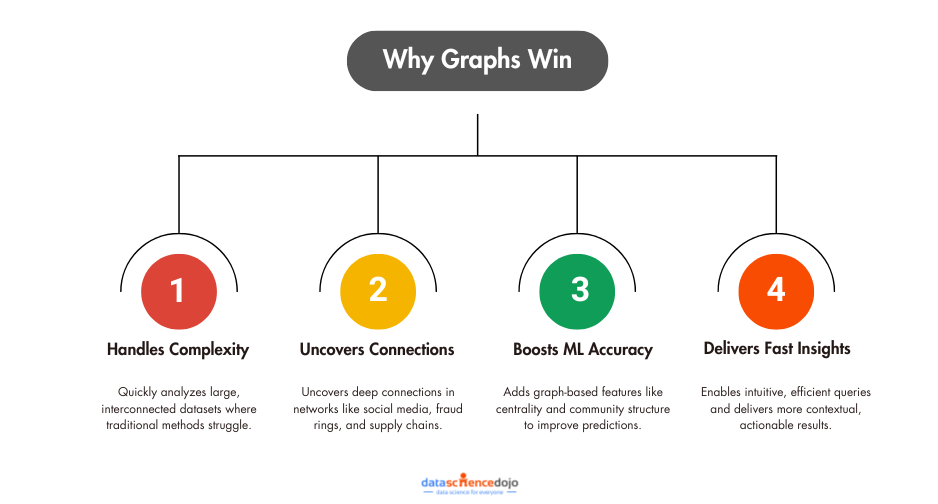In today’s data-driven world, businesses are constantly collecting and analyzing vast amounts of information to gain insights and make informed decisions. However, traditional methods of data analysis are often insufficient to fully capture the complexity of modern data sets. This is where graph analytics comes in.
One might say that the difference between data and graph analytics is like a movie script and a movie itself – but that is not entirely accurate. It can be compared to a movie that tells a story, while analytics is akin to the script that guides the movie’s plot. In contrast, data itself can be likened to a jumbled set of words, much like an incomplete puzzle that traditional methods cannot piece together.
What is Graph Analytics?
Graph analytics – a powerful method for discovering hidden relationships and patterns in your data that traditional analytics might miss.
At its core, graph analytics is the process of analyzing data structured as graphs. In this format, individual data points are represented as nodes (also called vertices), and the relationships or connections between them are depicted as edges. This structure is incredibly effective for modeling real-world networks, such as social networks, supply chains, recommendation engines, and biological systems.
Why Use Graphs Instead of Tables?
Traditional relational databases organize data in rows and columns, which works well for structured, straightforward data. However, when relationships between entities become complex and interwoven, it becomes difficult and inefficient to analyze using conventional methods. This is where graph analytics excels.
For example:
-
In a social media network, each user is a node, and their friendships or interactions are the edges.
-
In fraud detection, transactions and accounts form nodes, while edges represent the flow of money or data.
-
In supply chain logistics, suppliers, manufacturers, and distributors are nodes, and their transactions or deliveries are the connecting edges.
Graph analytics allows businesses and researchers to:
-
Uncover communities or clusters of tightly connected nodes.
-
Identify the shortest or most efficient paths between points.
-
Detect influential nodes (like key opinion leaders or fraud masterminds).
-
Spot anomalies that don’t follow usual connection patterns.
Key Advantage
The biggest benefit of graph analytics is that it treats relationships as first-class citizens. In traditional databases, relationships are implied and must be reconstructed through expensive join operations. In graph models, relationships are embedded directly into the data, making them easier and faster to analyze—especially when you need to traverse many levels of connections.
By visualizing and exploring data through this lens, organizations can gain deeper, more actionable insights, particularly in scenarios involving interconnected data.
How Graph Analytics are Better for Handling Complex Data Sets?

When it comes to managing large, interconnected data, few tools are as effective. Traditional data analysis methods struggle when the relationships between data points grow in volume and complexity.
Imagine trying to analyze a vast social media network—who’s connected to whom, how information spreads, and where influence lies. Doing this with spreadsheets or SQL queries would be like trying to count the stars in the sky without any tools. But with the right solution, it’s like having a high-powered telescope that reveals every connection with precision and clarity.
This approach thrives in environments where relationships matter. Whether it’s mapping out connections in financial fraud, tracing supply chain dependencies, or uncovering patterns in customer behavior, it simplifies what would otherwise be a tangled web of data. Queries that would require multiple joins and subqueries in traditional databases can be executed faster and more intuitively.
Even better, this technique complements modern machine learning practices. By engineering features based on node relationships, centrality, or community structures, data scientists can feed richer, more contextual information into their models. This often leads to significant performance gains, especially in predictive tasks like recommendation systems, fraud detection, and social influence modeling.
In essence, it’s not just about analyzing data—it’s about understanding how data points interact, and using those interactions to generate deeper, more accurate insights.
Explanation of Graph Structure in Data Representation
Graphs provide a highly intuitive and flexible way to represent data, especially when relationships between elements are just as important as the elements themselves. In a graph, data is structured as a network of nodes and edges.
-
Nodes (or vertices) represent individual entities—such as people, products, web pages, or locations.
-
Edges (or links) represent the connections or relationships between these entities—like friendships, purchases, hyperlinks, or routes.
This model mirrors how real-world systems operate. For example, in a transportation network, cities can be modeled as nodes and the roads connecting them as edges. In an e-commerce platform, users and products are nodes, and purchase or browsing behavior forms the edges.
This structure not only makes complex datasets easier to visualize but also simplifies the process of identifying intricate patterns, dependencies, and communities that might otherwise go unnoticed. Instead of analyzing isolated rows in a spreadsheet, you’re exploring an ecosystem of interactions.
Comparison to Traditional Methods of Data Analysis
Trying to analyze deeply connected data with traditional methods can feel like solving a jigsaw puzzle with half the pieces missing. You might get a rough idea of the picture, but key parts are still obscured.
Conventional techniques—like statistical modeling or standard machine learning—are excellent for structured, tabular data. They excel at recognizing trends, correlations, and outliers within flat datasets. However, they often fall short when the true value lies in how data points relate to each other. For instance, identifying the most influential user in a social network or detecting fraud across a network of transactions can become highly complex and inefficient without the right tools.
In contrast, by applying a graph-based approach, it’s like discovering the missing puzzle pieces. Suddenly, the scattered fragments start to make sense. You’re able to uncover hidden connections, detect clusters or communities, and trace the flow of information or influence through a network. This perspective opens up a new dimension of insights—one that’s often invisible to traditional techniques.
Insights from Industry Experts on Real-World Applications
In our webinar, “Introduction to Graph Analytics,” attendees learned from industry experts Griffin Marge and Scott Heath as they shared insights on the power of graph analytics and discovered how one can begin to leverage it in their own work.
During the introductory session, a comprehensive overview of GraphDB was provided, highlighting its unique features and the ideal use cases for graph technology. Following this, the session focused on the specific use case of fraud detection and featured a demonstration of a potential graph-based solution.
Summing it all up, this talk will help you in understanding how graph analytics is being used today by some of the world’s most innovative organizations. So, don’t miss out on this opportunity to expand your data analysis skills and gain a competitive edge.
Conclusion
All in all, graph analytics is a powerful tool for unlocking insights in large and complex data sets that traditional methods of data analysis cannot fully capture. By representing data as a graph structure with nodes and edges, graph analytics allows for a more comprehensive understanding of relationships between data points. If you want to expand your data analysis skills and stay ahead of the curve, graph analytics is a must-have tool in your arsenal.
Written by: Hamza Mannan Samad





